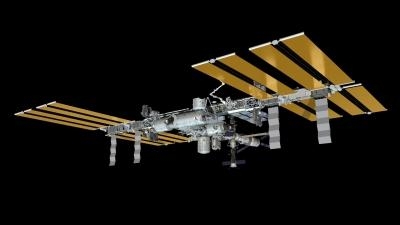Results To Be Published In The Journal Physical Review Letters
The international team running the Alpha Magnetic Spectrometer (AMS1) on Wednesday announced the first results in its search for dark matter. The results, presented by AMS spokesperson Professor Samuel Ting in a seminar at CERN2, are to be published in the journal Physical Review Letters. They report the observation of an excess of positrons in the cosmic ray flux.

The AMS results are based on some 25 billion recorded events, including 400,000 positrons with energies between 0.5 GeV and 350 GeV, recorded over a year and a half. This represents the largest collection of antimatter particles recorded in space. The positron fraction increases from 10 GeV to 250 GeV, with the data showing the slope of the increase reducing by an order of magnitude over the range 20-250 GeV. The data also show no significant variation over time, or any preferred incoming direction. These results are consistent with the positrons originating from the annihilation of dark matter particles in space, but not yet sufficiently conclusive to rule out other explanations.
“As the most precise measurement of the cosmic ray positron flux to date, these results show clearly the power and capabilities of the AMS detector,” said AMS spokesperson, Samuel Ting. “Over the coming months, AMS will be able to tell us conclusively whether these positrons are a signal for dark matter, or whether they have some other origin.”
Cosmic rays are charged high-energy particles that permeate space. The AMS experiment, installed on the International Space Station, is designed to study them before they have a chance to interact with the Earth’s atmosphere. An excess of antimatter within the cosmic ray flux was first observed around two decades ago. The origin of the excess, however, remains unexplained. One possibility, predicted by a theory known as supersymmetry, is that positrons could be produced when two particles of dark matter collide and annihilate. Assuming an isotropic distribution of dark matter particles, these theories predict the observations made by AMS. However, the AMS measurement cannot yet rule out the alternative explanation that the positrons originate from pulsars distributed around the galactic plane. Supersymmetry theories also predict a cut-off at higher energies above the mass range of dark matter particles, and this has not yet been observed. Over the coming years, AMS will further refine the
measurement’s precision, and clarify the behavior of the positron fraction at energies above 250 GeV.
"The AMS cosmic ray particle results announced today could help foster a new understanding of the fields of fundamental physics and astrophysics," said NASA administrator Charles Bolden. "I am confident that this is only the first of many scientific discoveries enabled by the station that will change our understanding of the universe. Multiple NASA human spaceflight centers around the country played important roles in this work, and we look forward to many more exciting results from AMS.
"For more than 50 years, NASA has pushed the boundaries beyond Earth to unveil the underlying architecture of the cosmos, revealing new knowledge about our place within it. The International Space Station is a gateway to the universe, teaching us how humans can live, work, and thrive in space as we endeavor to venture deeper into the solar system. It's a remarkable testament that the orbital laboratory could play such an important supporting role in research at the very smallest scale of the physical universe. It's proof positive the space station is humanity's greatest achievement in low-Earth orbit."
 ANN's Daily Aero-Linx (04.15.24)
ANN's Daily Aero-Linx (04.15.24) Classic Aero-TV: 'No Other Options' -- The Israeli Air Force's Danny Shapira
Classic Aero-TV: 'No Other Options' -- The Israeli Air Force's Danny Shapira Aero-News: Quote of the Day (04.15.24)
Aero-News: Quote of the Day (04.15.24) Airborne 04.16.24: RV Update, Affordable Flying Expo, Diamond Lil
Airborne 04.16.24: RV Update, Affordable Flying Expo, Diamond Lil ANN's Daily Aero-Term (04.16.24): Chart Supplement US
ANN's Daily Aero-Term (04.16.24): Chart Supplement US



